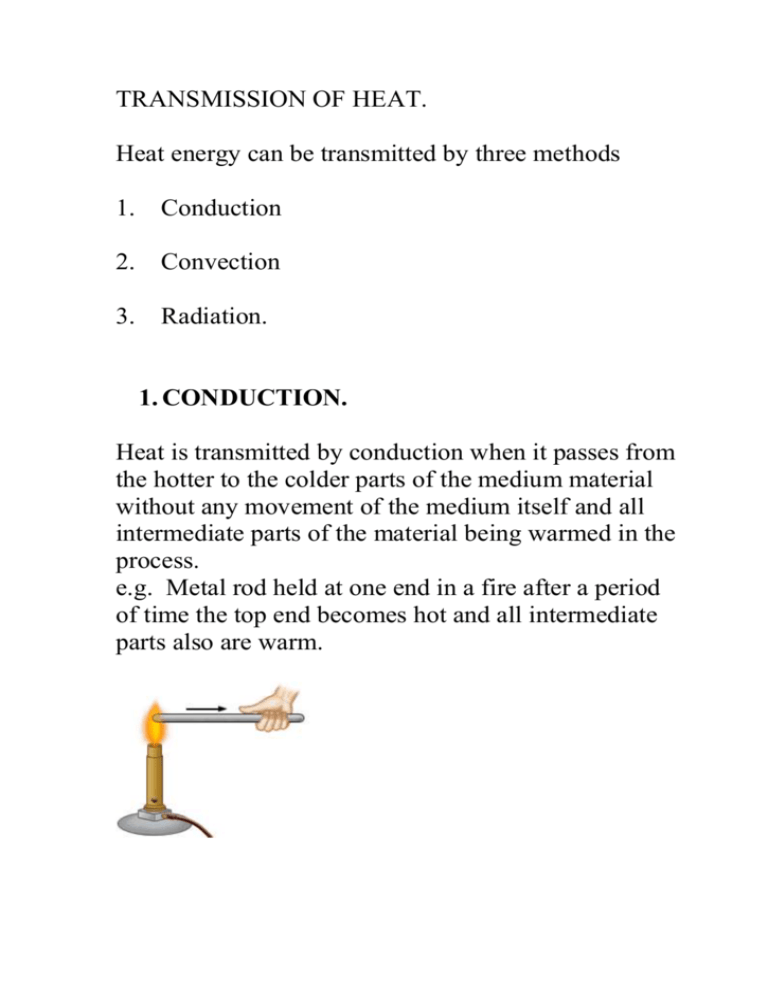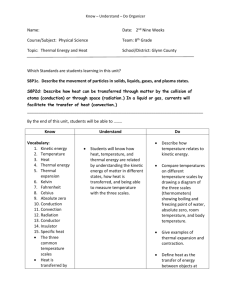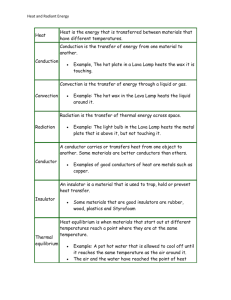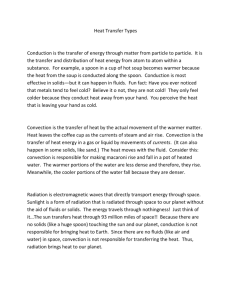Lecture 5: Heat transmission
advertisement

TRANSMISSION OF HEAT. Heat energy can be transmitted by three methods 1. Conduction 2. Convection 3. Radiation. 1. CONDUCTION. Heat is transmitted by conduction when it passes from the hotter to the colder parts of the medium material without any movement of the medium itself and all intermediate parts of the material being warmed in the process. e.g. Metal rod held at one end in a fire after a period of time the top end becomes hot and all intermediate parts also are warm. A metal contains some free (conduction ) electrons which are free to move through the material. When an metal is heated these free electrons gain kinetic energy and their speed is increased. The higher energy electrons drift towards the cooler parts of the material thereby increasing the average kinetic energy and heating. Recall that the kinetic energy of the electrons of the material is proportional to the temperature of the material. Most metals are good conductors i.e they easily transmit heat energy by conduction. Bad conductors are called insulators i.e they do not easily transmit heat by conduction e.g. wool, wood, most liquids and gases. THERMAL CONDUCTIVITY. Thermal conductivity is defined as the Heat energy flowing through a piece of material per second which is 1m in length, 1 m2 in cross-sectional area and has a temperature difference of 1oC between its ends. Symbol k Q kAT2 T1 t x Where Q = Heat energy flowing through the material A = T2 = Temperature at face 2 i.e the higher temp T1 = Temperature at face 1 the lower temp t = x = Area of the material through which the heat flows time taken length of the material through which the heat flows k = Thermal conductivity of the material S.I. Units of k Rearranging the equation making k the subject gives Qx k tAT Units are Joules metre Joules 2 seconds metre Kelvin seconds metre Kelvin Watts metre Kelvin Typical Values. Substance k (W/m K) Copper 400 Lead 36 Steel 50 Glass 1.05 Polystyrene 0.035 The thermal conductivity of good conductors is a high value e.g copper = 400 W /m oC What does this value mean ? The thermal conductivity of a good insulator is low e.g. polystyrene = 0.035 W / m oC Loss of heat by conduction is reduced by construction of double walls with the space between them packed with a substance with low conductivity ( insulator ). This process is called LAGGING. 2. CONVECTION. Convection in the most general terms refers to the movement of molecules within fluids (i.e. liquids, gases). In fluids, convective heat transfer takes place through both diffusion – the random Brownian motion of individual particles in the fluid – and by advection, in which matter or heat is transported by the larger-scale motion of currents in the fluid. Density is defined as mass per unit Volume. As the fluid is heated the Volume increases, the mass is constant therefore the density decreases. Hot fluids are less dense than cold fluids and will rise therefore convection currents (circular currents or movement within a fluid) due to different densities of the hotter and cooler parts are set up When heat is transferred by the circulation of fluids due to buoyancy from the density changes induced by heating itself, then the process is known as free or natural convective heat transfer. How does a radiator heat an entire room? The key is convection currents. The hot radiator sets up convection currents that transfer thermal energy to the rest of the room and eventually heat the entire room. How do convection currents work? The hot radiator warms the air that is closest to the radiator. The warm air expands, becomes less dense and rises to the top of the room. When the air reaches the top of the room it is pushed sideways towards the far wall by the more recently warmed air rising from the radiator below. In this way warm air moves to the other side of the room. Once on the other side of the room the air drops down both because it has cooled a little and because the air behind it continues to push on it. The air then continues to circulate back to the radiator and repeat the process. By continuing to circulate, the convection current transfers heat energy to the other side of the room and heats the entire room. This process can work in any fluid, whether a liquid or a gas. Because matter must circulate for convection currents to transfer thermal energy convection currents can not work in a solid. However they can efficiently transfer heat in a fluid. There are other examples of convection Domestic heating system With a convection circulation system set up, the hot water storage tank gradually becomes filled with hot water from the top downwards. When hot water is run off, an equal volume from the cold supply tank enters the hot storage tank at the bottom. The whole system is thus kept constantly full of water and no air can enter. Convection currents in the atmosphere and in the oceans are responsible for most meteorological changes. Clouds are formed when convection currents over the earth's surface carry warm, moist air upwards, where it expands and cools. The Trade Winds are formed when hot air over the equator rises and colder air flows in to take its place. Land and sea breezes. Because water has a much higher specific heat capacity that do sands or other crustal materials, for a given amount of solar irradiation water temperature will increase less than land temperature. Regardless of temperature scale, during daytime, land temperatures might change by tens of degrees, while water temperature change by less than half a degree. Conversely, water's high specific heat capacity prevents rapid changes in water temperature at night and thus, while land temperatures may plummet tens of degrees, the water temperature remains relatively stable. Moreover, the lower heat capacity of crustal materials often allows them to cool below the nearby water temperature. Air above the respective land and water surfaces is warmed or cooled by conduction with those surfaces. During the day, the warmer land temperature results in a warmer and therefore, less dense and lighter air mass above the coast as compared with the adjacent air mass over the surface of water. As the warmer air rises by convection, cooler air is drawn from the ocean to fill the void. The warmer air mass returns to sea at higher levels to complete a convection current. Accordingly, during the day, there is usually a cooling sea breeze blowing from the ocean to the shore. The greater the temperature differences between land and sea, the stronger the land breezes and sea breezes. After sunset, the air mass above the coastal land quickly loses heat while the air mass above the water generally remains much closer to it's daytime temperature. When the air mass above the land becomes cooler than the air mass over water, the wind direction and convection currents reverse and the land breeze blows from land out to sea. (b) land breeze 3. Radiation. Thermal radiation is electromagnetic radiation emitted from the surface of an object which is due to the object's temperature. Infrared radiation from a common household radiator or electric heater is an example of thermal radiation, as is the light emitted by a glowing incandescent light bulb. Thermal radiation is generated when heat from the movement of charged particles within atoms is converted to electromagnetic radiation. Any object that is hot gives off light known as Thermal Radiation (or sometimes Blackbody Radiation ). The hotter an object is, the more light it emits. And, as the temperature of the object increase, it emits most of its light at higher and higher energies. (Higher energy light means shorter wavelength light.) The relationship between the amount of light emitted, its wavelength and its temperature is an equation known as the Planck Law, named after the German physicist Max Planck, who first discovered it. For a hot object at a given temperature, T, the equation gives the amount of light emitted at each wavelength. Thermal Radiation from Astronomical Objects Object Temperature (K) Peak Wavelength Region Cosmic Background 3 1mm Microwave (IR-Radio) Molecular Cloud 10 300µm Infrared Humans 310 9.7µm Infrared Incandescent Light Bulb 3000 1µm 10,000Å IR/Visible Sun 6000 5000Å Visible Hot Star 30,000 1000Å Ultraviolet Heat is transmitted by Radiation when it is passed from one place to another without the aid of a material medium and does not heat the space through which it travels. All hot bodies radiate the also absorb radiant heat. If Rate of heat absorbed = Rate of heat radiated Then the body has a constant temperature. The rate at which a body radiates heat depends on Temperature of the body Surface area of the body Nature of the surface The Stefan–Boltzmann law, also known as Stefan's law, states that the total energy radiated per unit surface area of a body in unit time is directly proportional to the fourth power of the body's temperature in Kelvin T (also called absolute temperature): Q R AT 4 t Where R = Rate of energy emitted in Watts Stefans constant = 5.67x10-8 W/m2K4 emissivity of the material T = Temperature of the surface in Kelvin A = Surface area in m2 A black body is an object that absorbs all electromagnetic radiation that falls on it. The emissivity of a material (usually written ε) is a measure of a material's ability to radiate absorbed energy. A true black body would have an ε = 1 while any real object would have ε < 1. Emissivity is a dimensionless quantity (does not have units). In general, the duller and blacker a material is, the closer its emissivity is to 1. The more reflective a material is, the lower its emissivity. Highly polished silver has an emissivity of about 0.02. Problem Sheet 4 Conduction and Radiation. Conduction. Question 1 A glass window 0.40cm thick measures 83cm by 36cm. How much heat flows through this window per minute if the inside and outside temperatures differ by 13oC ? Question 2. Two metal rods of equal length-one aluminium, the other stainless steel-are connected in parallel with a temperature of 14oC at one end and 130 o C at the other end. Both rods have a circular cross section with a diameter of 3.00cm Determine the length the rods must have if the combined rate of heat flow through them is to be 40.0 J per second. Question 3. Water is boiled in a rectangular steel tank heated through a base which is 5 mm thick. If the water level falls at a rate of 1 cm every 5 minutes calculate the temperature of the lower surface of the base of the tank. Question 4. Consider a double-paned window consisting of two panes of glass, each with a thickness of 0.550cm and an area of 0.740 m2, separated by a layer of air with a thickness of 2.00 cm. The temperature on one side of the window is 00C; the temperature on the other side is 23oC. In addition, note that the thermal conductivity of glass is roughly 36 times greater than that of air. Approximate the heat transfer through this window. Radiation. Question 1. The silica cylinder of a radiant wall heater is 60 cm long and has a radius of 5 mm. If it is rated at 1.5 kWatts estimate its temperature when in operation. Assume and 5.67 x 10-8 W / m2 K4 Question 2. Assuming your skin temperature is 37.2oC and the temperature of your surroundings is 23.4 , determine the length of time required for you to radiate away the energy gained by eating a 320-Calorie ice cream cone. Let the emissivity of your skin be 0.915 and its area be 1.27 m2. 1 Calorie = 1000 calories 1 calorie = 4.186 J. Heat Loss in Buildings. Buildings have windows, walls, doors floors and ceilings through which they can lose heat. In the future houses or buildings will have to produce a Building Energy Ratings (BER) under the requirements of the Energy Performance of Buildings Directive (EPBD). Most modern buildings use double glazed windows and cavity walls which improve the rating value. In this assignment we aim to calculate a value for the heat loss by conduction rating from the lab we are working in. The heat loss rating is calculated from U values Temperature difference and Areas The model of any element of a building usually consist of a number of layers each having its own thermal conductivity value. So how do we work out the rate of heat flow in this case. U Values U values are quantities used by architects and heating engineers for working out the thermal energy flow within buildings. In particular the energy losses through windows, doors and walls may be calculated Heat energy only flows when there is a temperature difference and the temperature difference is given as T P UAT Where P = Heat loss rating = Rate of energy flow through the element = Power measured in Watts. A = Area of the material measured in m2. T = temperature difference measured in oC or Kelvin U values can be calculated for different types of walls, windows, floors and roofs. The values have been obtained by direct measurement rather than theoretical calculation. U values in the cases of buildings are more realistic than thermal conductivity values as they take into account any hollow components or elements which contain a number of different components. e.g Double glazing in windows consists of three components glass air glass Calculation of U values. The U value for an element is given by the equation U 1 R Where R = the thermal resistance of the material given by R Where l k l = thickness in m k = thermal conductivity in W/mK and R = the sum of the thermal resistance for each component (material) of the element. There are also standard R values for the layers of still air on either side of an element. For an inside layer the value is Rsi = 0.12 m2K/W For an outside layer the value is Rso = 0.06 m2K/W Question 1. Calculate the heat loss in 1 hour through single glazed glass of thickness 12 mm and area 3m x 6m, if the inside temperature is 19oC and the outside temperature is 10oC. k(glass) = 1.2 Wm-1K-1 Question 2. Repeat question 1 if the glass is changed to double glazed where the double glazing consists of three elements 4mm glass on each side of a 6mm air cavity. k(air) = 0.025 Wm-1K-1 Question 3. If the internal wall has an area of 70 m2 and consist of 12.5 mm plasterboard each side of 100 mm fibreglass calculate (i) the U value of the wall (ii) the rate of heat loss through the wall if the temperature difference is 3K (iii)the total loss of heat through the wall in a time of 2 hours. k(plasterboard) = 0.25 Wm-1K-1 k(fibreglass) = 0.035 Wm-1K-1









